How to Set Up a Year-Long Math Journal Center
Learn how to create a year-long math journal center in kindergarten.
Math journals are an excellent way to work on math standards without using worksheets, allow students to show their thinking and learn how to organize written math work.

Here’s why and how I created a math journal center that lasted all year long in our classroom. This center fits right into how I teach math in small groups in kindergarten.
Why I created a math journal center
Since I teach math in small groups, I need the rest of my class to learn independently. Setting up a math journal center is one way I have students learn independently.
I knew that I’d need a math center where students would record their thinking in written form using pictures, numbers and sometimes words… because they have to learn to write during math. But I wasn’t about to use worksheets.
I loathe worksheets.
So, to replace worksheets in my classroom (and I literally just hid them away in my cupboards until the end of the year when I recycled them) I purchased a set of composition notebooks for my class.
With these notebooks, we had the makings of a math journal center, or recording zone, as I like to call it. Of course, you can call it a station, zone, center or whatever you like.
Continue reading: Two reasons why I love using math journals in kindergarten
How it works
This center is pretty straightforward, but here’s how it works:
- Students watch me model a math prompt.
- They learn how to “read” the directions using picture clues.
- They write the date and glue in the math prompt in their composition notebook.
- They work through the prompt choosing appropriate materials when it is their turn to visit this center.
- They record their thinking using pictures, color, numbers and eventually words.
- They often share their work with the class and/or it is reviewed by the teacher before it gets returned to them.
They can learn to write, draw and organize their thinking using plain notebook paper. It won’t all happen during the first three weeks of kindergarten, but they will grow by leaps and bounds over the year.
What you need
To set up a math journal center, here are the basic things you’ll need:
- glue (sticks or bottles)
- a composition notebook for each student
- math prompts
- two-ended bookmarks
- student pencil boxes or a caddy of writing utensils
- manipulatives
- paper to print math prompts
- Ziploc bags to store manipulatives in sets
- basket to hold group notebooks
You don’t have to have a specific area where kids sit to work – they can simply do their journaling wherever it’s convenient.

If you have a little shelf space to keep student notebooks in baskets by groups and a three-drawer Sterilite organizer – that is all the setup space you need.

Just label your baskets in a way that is easy to change, because the names of the students in each group should/will change as the year goes on.
How to make it last all year
In order to make math journals something they could do all year long, I needed it to bet set up as a regular routine thing. So they will know what to do with a little modeling, instruction, and praise.
You’ll need to decide how often your students will visit this math center and that will help you determine how many prompts you need each week.
My students had two journal prompts each week.
To make a math center year-long, I think you need:
- math prompts that look the same from week to week
- materials available in the same location
- a grading “rubric” (and I loosely use this term)
- a plan to have students finish or redo work
- a way to share student work with parents
Let’s talk about each of those components so that it doesn’t feel overwhelming.
1. Create kinder-friendly math prompts
Math prompts are what students will work from each week when they come to this center.
Math prompts in kindergarten should:
- be open-ended whenever possible
- have picture direction clues
- be standards-based
- usually require the use of manipulatives
- be differentiated relatively easily
You want students to keep working at this center and completely avoid the potential problem of having “fast finishers” altogether. Make your prompts open-ended so students keep working at this center until time is done.

Use picture clues so that students can follow along visually when you’re introducing and modeling the prompt. Then they can use those clues to help them recall the directions, steps and prompt when working independently.
Only pick prompts that are working towards what you’re working towards – and that is mastering standards. Choose a variety of standards to hit over time, but don’t feel like every standard is worthy of turning into a journal prompt.
‘Cuz they’re not.
Kindergarten students are such concrete learners that they should have access to and use manipulatives while they are working. They should attempt to draw their manipulatives in their notebooks to show their work. It’s age-appropriate.
Format your math prompt tasks so that if you need to differentiate the difficulty for different groups of students, that it’s easy on you.
I’ve already made a whole year’s worth of prompts that fit the bill for kindergarten. You can buy them in my guided math pack.
I stored the current math prompts in the top drawer of a medium-sized Sterilite three-drawer unit. Students would take one and glue it onto the next available page in their math journal and show their work on that page(s).

2. Make manipulatives available
You’ll want to have some basic manipulatives on hand to help students learn.
Here are some ideas:
- linking cubes
- pattern blocks or foam shapes
- a camera (or iPad) to take photos
- stamps
- teddy bear counters
- dice
- dominoes
- 2D/3D objects
- number lines 0-10, 0-20
- ten frames
- high-interest objects (assorted buttons, beads, keys, shape macaroni, legos or counters)
- number cards
And I’ve found that the key is to already have these manipulatives in sets.
I would put out a set of manipulatives students needed to complete the prompt into a Ziploc bag or if it was a set of pattern blocks or base ten blocks, those were kept in pencil boxes. If my largest group size was 7 students, I would have 7 sets of those materials pre-made.

We stored these in the next two drawers of the Sterilite organizer.
That way they could carry it to their workspace from where we kept all of our math journal materials, clean up and return them easily for the next group.
Bonus tip! Here are two ways to keep “sets” separated if needed:
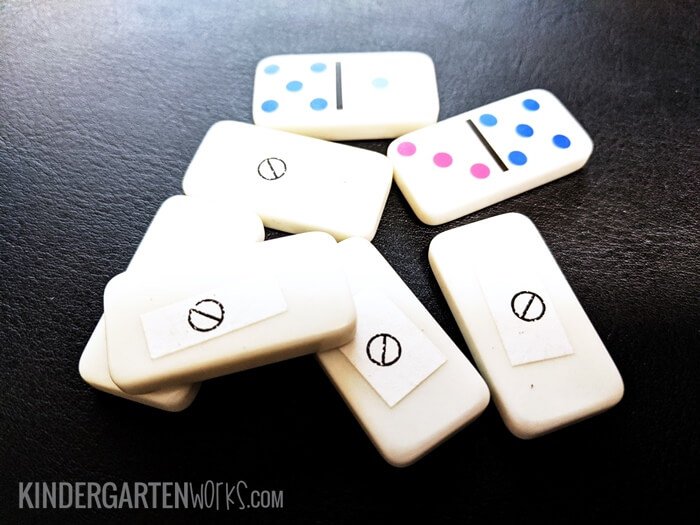
If you have a set of materials like dominoes that need to be kept as a set, create quick, picture labels to keep pieces together. Print a symbol multiple times (using the Wingdings or Webdings font) onto a label or a few labels. Cut the symbols apart and stick them onto the back of each domino in the set. Label the bag or container with the symbol so all pieces get returned to the right one.

Use color to separate sets of printed materials like cards. Students have an easier time cleaning up when they can visually see that all of their purple cards have been picked up right next to their partner who was using yellow cards.
3. Check student work
When it comes to grading in kindergarten – I don’t. Checking these math journals is the closest thing I came to grading.
We used a rubric and a bookmark to make things easy.
Glue a rubric onto the inside front cover of the math journal.
Use a super simple rubric
A simple emoji face rubric was an easy way to check and document work.

Students could earn:
- a smiley face – if all parts were completed and accurate
- a straight face – if only some parts were completed or had incorrect work
- a sad face – if the student didn’t try their best or follow the directions
You can add words too, like to note how hard a student tried, if they are showing growth, used good organization or if they didn’t stay on task. Consider it documentation for you and for their parents.

Use a two-ended bookmark
We used a two-ended bookmark to help make journaling go smoother.

The bookmark helped us find current work quickly without having to flip through a gazillion notebook pages.
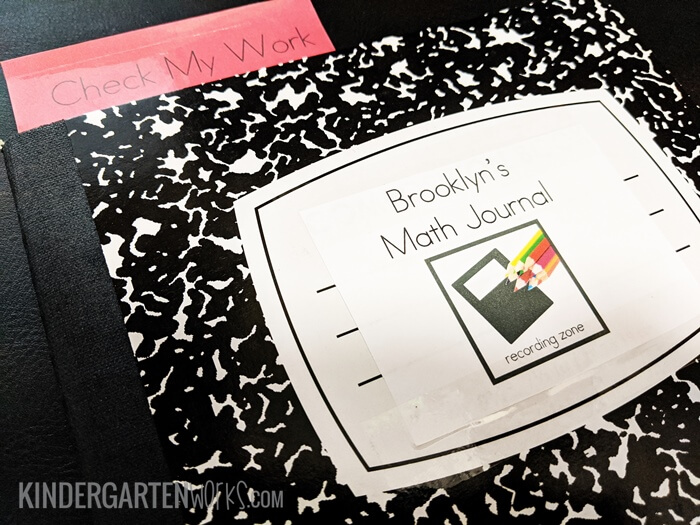
Students tucked them in with the red end sticking out if it was ready to be checked (at the end of their center).
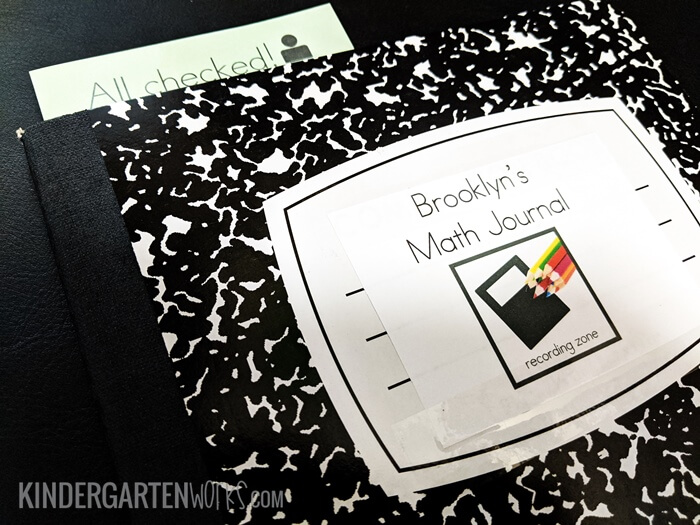
Then, after checking their work, I’d flip it to the green end so they knew it was ready to be put away.
What to do when student work isn’t done, good enough or is completely wrong
Let’s be real – it’s kindergarten. And we’re working with all kinds of kids. I won’t pretend every journal entry was completed beautifully.
That’s not my goal. Our goal is to use these to learn to organize their work and show work in ways that is meaningful to them. They don’t exactly know how to do that in the beginning.
Now there are times when students goof off and don’t complete their work. When it’s chalked up to behavior or being off-task, that’s an easy sad face documentation mark.
I set those math journals aside and students redo the prompt the next morning after they’ve completed their morning routine.
If a student gets the work wrong but did make good attempts, then I have some great information I can use and plan small group lessons around that need.
I also set those math journals aside and have the student redo the prompt the next morning if I can give them one-on-one assistance to get them back on track. Or if our morning is hectic, I hang onto it for math time and try to have them sit near me so I can help them through a couple of steps so not all is lost.
Plan to share work with parents
Parents like to see what’s going on in the classroom. You can share student math journals with parents to facilitate good communication.
Since my students were no longer taking home worksheets daily, I needed a way to have students share their math journal work.
I didn’t want them taking journals home each week since that would increase the likelihood some would not return – but I did compromise and send them home once each month or twice a quarter.

I sent them home in a Ziploc bag with a note stapled to the inside so parents knew how to talk through their child’s work with them and to return them back to school.
You could also take photos of student journal entries (or teach them to do it) and upload them to their SeeSaw portfolios (or some other digital sharing platform like Classdojo or Bloomz).
Parents were able to use the directions on the prompts, the work, and my emoji faces to get a good feel for their child’s work in math.
How to keep it simple
Okay – let’s look at this from the perspective that you want to work smart and keep it simple.
You want your students to work independently, you want them to grow in their math skills and you don’t want a crazy amount of work each week to keep this center running.
Well here are three ways I think you do that.
1. Differentiate doesn’t mean extra work
Differentiate only when you need to, and not for every prompt.
With most math prompts, you probably won’t need to make any changes. But if you do, change the number range students are working with to better fit their independent skill range.
Use symbols so students know which prompt copy is for them.

Remember, differentiating doesn’t mean just giving extra work to higher students – give them work that goes deeper and is more challenging.
2. Focus on content
Pick math prompts that help you teach! Go for math prompts that require learning to write and use numbers for a purpose and eventually use words to help add clarity to their work.
Skip the traditional math prompts: “I bought 3 pumpkins. My dad bought 2 more. How many pumpkins were there in all?”
I’m not saying story problems are bad – they just fit better during calendar binder time or as part of a teacher-led small group lesson instead.
3. Introduce, review, praise
When you introduce a math prompt – be very specific about what you want students to do… but don’t always show them exactly how to do it or at least the whole thing.
Begin modeling what you want to see, but leave room for students to find ways to show their thinking.
For example, if you wanted students to show how they figured out multiple ways to make 5, perhaps they could organize their work by drawing a circle around each way. Or maybe they will draw a line in between each way. Or maybe they will do each way in a different color.
If your students don’t all do the prompt on the same day (I only had two out of four groups doing a prompt on any given day) then be sure to review the prompt for your students on the second day.
I planned for my highest groups to do the prompt on the first day or rotating through centers so that my students who needed more support would see the prompt twice. The would see the introduction and review.
Use student examples from the previous day to help students see ways of showing their thinking, organizing their work, being neat and find specific things to praise that you want to see others try too. Just pick one thing from each example you pick to edify.
Use the system you have in place to your advantage so your students can work independently, grow in their math skills and you aren’t doing a crazy amount of work each week to keep this center running.
Conclusion
There you have why and how I created a math journal center that lasted all year long in our classroom. Plus, we covered how the benefits of sharing work with parents and keeping it simple can make the work you do to set up this center easy to maintain each week.
If you’re interested in grabbing my 74 math journal prompts – I’ll include everything you need to help you get this center set up! This guided math pack includes the journal bookmarks, name labels, rubric, parent note and more.

![Composing and Decomposing Numbers: What This Looks Like in Kindergarten [3-Part Series]](https://www.kindergartenworks.com/wp-content/uploads/2013/05/Composing-and-Decomposing-Numbers-in-Kindergarten-I-love-the-ideas-in-this-series.jpg)
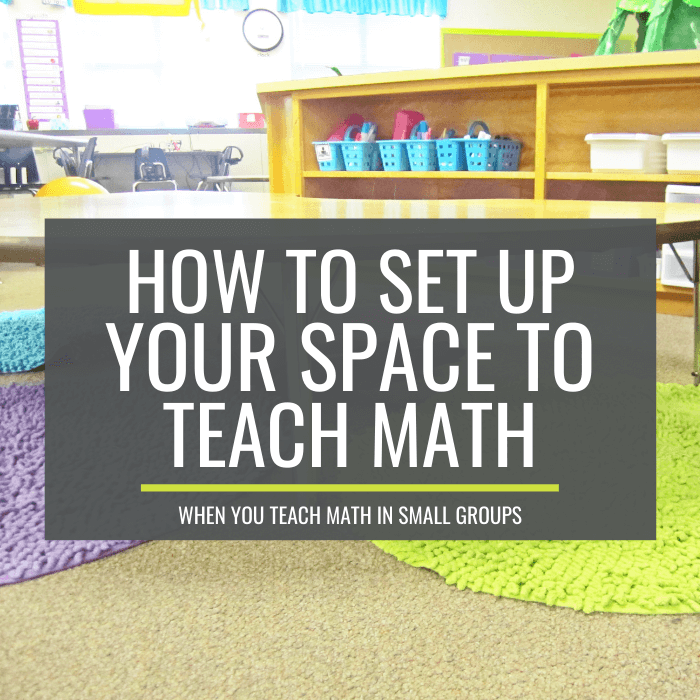
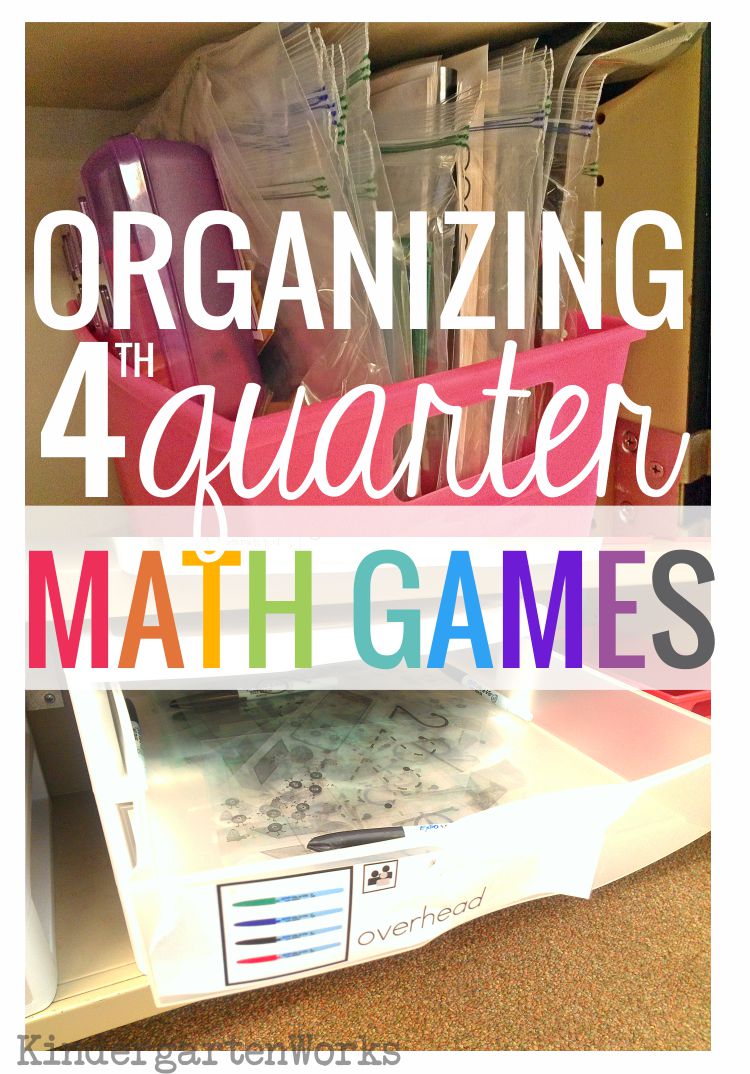



I don’t understand how your minders read the prompts. My students are not at that reading level.
Hi Alyce, I don’t expect them to read it either. Students watch me model the math prompt and at that time I am teaching them how to “read” the directions and use the picture clues. So that way when it’s their turn to complete it, they can use the picture clues and words/number they recognize in the prompt to do it on their own. We review every day what the prompt is supposed to be. I hope that can help.
– Leslie